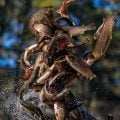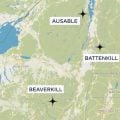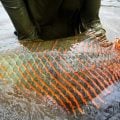Bird Cams and Digital Possibilities
As my wife remarked to me just last week as she took one frenzied photo after another of the elk in Estes Park, Colorado, digital “film” is a very, very good idea. Beyond allowing an average photographer to capture moments that would otherwise require perfect timing and framing, it allows researchers to do some very interesting things, like attaching small cameras to wildlife in order to get an animal’s-eye view of everyday life.
Scientists at the National Institute of Polar Research in Japan and the British Antarctic Survey attached tiny digital cameras to three albatrosses in the Southern Ocean to record their search for food. The result — 28,000 images later — was proof that the birds followed killer whales in their hunt for food.
Of course, there are probably other ways to get information of this sort. For example, if you could figure out how to interview a western kingbird — seen here flying first class on the back of a worried raptor — you could learn a lot about the escape tactics of the red-tailed hawk.
NYT: Scientists Study Fires For Clues to Saving Wildlife
Worst River Craft Ever?











